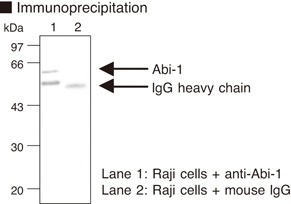Anti-Abi-1 (Abl interactor 1) (Human) mAb
| Code | Size | Price |
|---|
| MBL-D147-3 | 100 ul | £328.00 |
Quantity:
Prices exclude any Taxes / VAT
Overview
Host Type: Mouse
Antibody Isotype: IgG1
Antibody Clonality: Monoclonal
Antibody Clone: 1B9
Regulatory Status: RUO
Target Species:
- Hamster
- Human
- Mouse
Applications:
- Immunohistochemistry (IHC)
- Immunoprecipitation (IP)
- Western Blot (WB)
Shipping:
4°C
Storage:
-20°C
Images
Documents
Further Information
Applications:
WB - 1 ug/mL (chemiluminescence detection system) IP - 2 ug/200 uL of cell extract from 5x106 cells IHC - 5 ug / mL
Heat treatment is necessary for paraffin embedded
sections.
Microwave oven; 2 times for 10 minutes each in citrate
buffer (pH 6.5)
Background:
Abl interactor (Abi) proteins are
c-Abl-binding proteins that bind to both the Src homology
3 (SH3) domain and the C-terminal proline-rich regions of
Abl kinase through dual SH3-PXXP interactions. Two
highly related genes, abi-1 and abi-2, were cloned. In
addition to the interaction with Abl kinase, Abi proteins
also interact with other signaling molecules. Recently, it
has been reported that Abi-1 dramatically promoted
c-Abl-mediated tyrosine (Tyr296) phosphorylation of Mena
[mammalian homologue of Drosophila Enabled (Ena)] by
interacting with both proteins.
Concentration:
1 mg/mL
Formulation:
100 ug IgG in 100 ul volume of PBS containing 50% glycerol, pH 7.2. No preservative iscontained.
Gene IDs:
Human: 10006 Mouse: 11308
Immunogen Translated:
Recombinant human Abi-1 was expressed in Escherichia coli
Reactivity:
This antibody reacts with Abi-1 (65
kDa) on Western blotting.
Shelf Life:
3 years
Source:
This antibody was purified from hybridoma
(clone 1B9) supernatant using protein A agarose. This
hybridoma was established by fusion of mouse myeloma
cell Sp/O with Balb/c mouse splenocyte immunized with a
human recombinant Abi-1 expressed in E. coli.
Target:
Abi1
References
1) Tani, K., et al. J. Biol. Chem., 278, 21685-21692 (2003)
Clone 1B9 is used in this reference.




